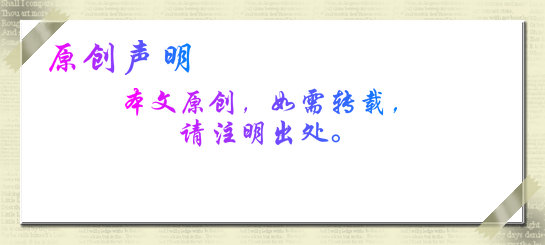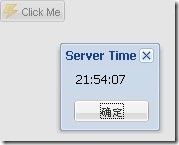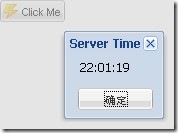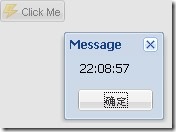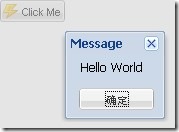http://examples.ext.net/#/Events/DirectMethods/Overview/
本文在几个月前写过一次,当时刚刚使用 Ext.Net,现在重新整理一下,说说自己的理解,并附上源代码。 本 Blog 的文章我可能因为翻译问题,代码问题,理解问题,表述问题等等,都会不定期的重新整理发一下。
本文内容
- DirectMethod 基础
- 从 DirectMethod 返回一个字符串
- 给 DirectMethod 传递多个参数
- 调用 DirectMethod 静态方法,并返回一个字符串
- 从静态 DirectMethod 返回一个自定义对象
- 禁用 DirectMethod ClientProxy 的创建
- 向代理函数传递 DirectMethod 配置
DirectMethod 提供了一种直接在客户端 JavaScript 代码中调用服务器端 .Net 方法的功能。
用 [DirectMethod] 属性来修饰服务器端 public 或 public static 属性的方法,会向客户端 JavaScript 代码“公开”服务器端方法。
注意:服务器端方法必须用 public 或 public static 修饰符。
这种调用服务器端方法往往很好用,可以解决很多动态创建控件和数据加载问题(例如,根据权限动态创建按钮),以及它们造成的页面呈现问题。
例如,当页面很多控件都是动态时,每次刷新页面,Ext.Net 在获得数据后,都会自己重新按照它的式样呈现数据,此时可能报脚本错误。
我经常遇到的情况是,Ext.Net.GridPanel 和 Ext.Net.Store 刷新问题。Ext.Net 的处理顺序是,先把数据加载到 Store 里(如 Store.DataSource=new DataTable(); Store.DataBind(); ),然后再用 GridPanel 呈现。因此,如果你的顺序是反的。先为 GridPanel 动态创建行或组按钮,再调用 GridPanel.Render(),之后,向 Store 绑定数据,就很可能出现刷新问题。
假设你只使用了 Page_Load 事件进行页面初始化,并在初始化时进行 if(!IsAjaxRequest) {…} 判断。如果 debug 程序,那么,Ext.Net 框架在页面第一次初始化时,IsAjaxRequest==false,表明这第一次不是 Ajax 请求。当你对页面进行操作,并调用了服务器端方法时,无论是通过 Ext.Net 何种方式调用,之后就全是 Ajax 请求,即 IsAjaxRequest==true,此时,与 ASP.NET 程序相比,你会发现很多方法都会执行,而且有些方法会反复执行很好几次。这就是 Ajax 程序的特点——多次向服务器端请求资源,只要它需要。并且,这些请求都是局部刷新页面。
所以,我通常是,在页面初始化时,如 Page_Load,尽量先将页面的整体情况呈现给客户,即 if(!IsAjaxRequest) {…} 里的代码。然后,根据用户对页面的动作,通过直接调用服务器端方法,获得数据,呈现给用户。
事前想好,如何呈现你的页面给用户其实重要。能很大程度减少页面刷新次数、页面响应时间,提升页面性能。
DirectMethod 基础
下面演示 DirectMethod 一个简单的例子,更新 <ext:Label> 控件。
<%@ Page Language="C#" %>
<%@ Register Assembly="Ext.Net" Namespace="Ext.Net" TagPrefix="ext" %>
<!DOCTYPE html PUBLIC "-//W3C//DTD XHTML 1.0 Transitional//EN" "http://www.w3.org/TR/xhtml1/DTD/xhtml1-transitional.dtd">
<html xmlns="http://www.w3.org/1999/xhtml">
<head runat="server">
<title></title>
<script runat="server">1:2: [DirectMethod]3: public void SetTimeStamp()4: {5: this.Label1.Text = DateTime.Now.ToLongTimeString();6: this.Label1.Element.Highlight();7: }8:</script>
</head>
<body>
<form id="form1" runat="server">
<ext:ResourceManager ID="ResourceManager1" runat="server" />
<ext:Button ID="Button1" runat="server" Text="Click Me" Icon="Lightning">
<Listeners>
<Click Handler="Ext.net.DirectMethods.SetTimeStamp();" />
</Listeners>
</ext:Button>
<br />
<ext:Label ID="Label1" runat="server" Text='<%# DateTime.Now.ToLongTimeString() %>'
Format="Server Time: {0}" />
</form>
</body>
</html>
运行结果:
图1 DirectMethod 基础
说明
- 在 Button1 客户端事件里,调用服务器端方法 SetTimeStamp 来更新 Label1 控件,并高亮显示。
- 另外,在 Ext.Net,当第一次请求页面时(此时为回发),IsAjaxRequest 为 false,之后为 true,因为之后的请求是 Ajax 请求。
从 DirectMethod 返回一个字符串
DirectMethod 会返回任何类型的对象。该对象序列化后,作为 result 参数发送给在 DirectMethod 中配置的回调函数 success(DirectMethod 方法成功时的客户端处理函数)。
<%@ Page Language="C#" %>
<%@ Register Assembly="Ext.Net" Namespace="Ext.Net" TagPrefix="ext" %>
<!DOCTYPE html PUBLIC "-//W3C//DTD XHTML 1.0 Transitional//EN" "http://www.w3.org/TR/xhtml1/DTD/xhtml1-transitional.dtd">
<html xmlns="http://www.w3.org/1999/xhtml">
<head runat="server">
<title></title>
<script runat="server">1:2: [DirectMethod]3: public string GetTimeStamp()4: {5: return DateTime.Now.ToLongTimeString();6: }7:</script>
</head>
<body>
<form id="form1" runat="server">
<ext:ResourceManager ID="ResourceManager1" runat="server" />
<ext:Button ID="Button2" runat="server" Text="Click Me" Icon="Lightning">
<Listeners>
<Click Handler="
Ext.net.DirectMethods.GetTimeStamp({
success: function (result) {
Ext.Msg.alert('Server Time', result);
}
});" />
</Listeners>
</ext:Button>
</form>
</body>
</html>
运行结果:
图2 从 DirectMethod 返回一个字符串
说明
- 在 Button1 客户端事件中,Ext.net.DirectMethods.GetTimeStamp(…) 是在客户端调用服务器端的方法 GetTimeStamp,success 是 Ext.net.DirectMethods 配置的回调函数,也就是说,当服务器端方法成功返回时,客户端需要根据返回值执行的操作。本例中,如果服务器端方法 GetTimeStamp() 成功返回服务器端当前时间,则客户端弹出这个时间警告。
给 DirectMethod 传递多个参数
如果服务器端 [DirectMethod] 方法要求参数,那么也要客户端 DirectMethod 传递给它相应的参数。
本例中,如果服务器端要求两个参数:sting 和 int,那么在客户端也要传递两个可靠的参数给服务器端的 [DirectMethod] 方法。
<%@ Page Language="C#" %>
<%@ Register Assembly="Ext.Net" Namespace="Ext.Net" TagPrefix="ext" %>
<!DOCTYPE html PUBLIC "-//W3C//DTD XHTML 1.0 Transitional//EN" "http://www.w3.org/TR/xhtml1/DTD/xhtml1-transitional.dtd">
<html xmlns="http://www.w3.org/1999/xhtml">
<head runat="server">
<title></title>
<script runat="server">1:2: [DirectMethod]3: public void LogCompanyInfo(string name, int count)4: {5: string template = string.Concat("{0} has approximately {1} employees.");6: string[] employees = new string[4] { "1-5", "6-25", "26-100", "100+" };7:8: this.Label1.Text = string.Format(template, name, employees[count]);9: }10:</script>
</head>
<body>
<form id="form1" runat="server">
<ext:ResourceManager ID="ResourceManager1" runat="server" />
<ext:Button ID="Button1" runat="server" Text="Click Me">
<Listeners>
<Click Handler="Ext.net.DirectMethods.LogCompanyInfo('Ext.NET, Inc.', 0);" />
</Listeners>
</ext:Button>
<br />
<ext:Label ID="Label1" runat="server" />
</form>
</body>
</html>
运行结果:
图3 给 DirectMethod 传递多个参数
调用 DirectMethod 静态方法,并返回一个字符串(Super Fast + Best Performance)
当调用一个 public 服务端方法,默认情况下,在执行整个页面生命期时,这个方法可以访问页面上所有 Web 控件。
而带 static 的 [DirectMethod] 方法,不会执行页面生存期,并且不能访问页面 Web 控件。这减少了处理开销,优化了性能。
<%@ Page Language="C#" %>
<%@ Register Assembly="Ext.Net" Namespace="Ext.Net" TagPrefix="ext" %>
<!DOCTYPE html PUBLIC "-//W3C//DTD XHTML 1.0 Transitional//EN" "http://www.w3.org/TR/xhtml1/DTD/xhtml1-transitional.dtd">
<html xmlns="http://www.w3.org/1999/xhtml">
<head runat="server">
<title></title>
<script runat="server">1:2: [DirectMethod]3: public static string GetTimeStamp()4: {5: return DateTime.Now.ToLongTimeString();6: }7:</script>
</head>
<body>
<form id="form1" runat="server">
<ext:ResourceManager ID="ResourceManager1" runat="server" />
<ext:Button runat="server" Text="Click Me" Icon="Lightning">
<Listeners>
<Click Handler="
Ext.net.DirectMethods.GetTimeStamp({
success: function (result) {
Ext.Msg.alert('Server Time', result);
}
});" />
</Listeners>
</ext:Button>
</form>
</body>
</html>
运行结果:
图4 调用 DirectMethod 静态方法,并返回一个字符串
说明
- Button1 客户端事件调用服务器端静态方法 GetTimeStamp(),获得服务器端当前时间。
注意:服务器端静态方法 GetTimeStamp() 中不能访问页面中的 Web 控件。
从静态 DirectMethod 返回一个自定义对象
DirectMethod 可以返回任何类型的对象。下面例子创建并返回一个 Customer 对象。
Customer 对象被序列化成 JSON,返回给客户端。在 DirectMethod 配置中,result 参数就是从服务器端返回的 Customer 对象。
<%@ Page Language="C#" %>
<%@ Register Assembly="Ext.Net" Namespace="Ext.Net" TagPrefix="ext" %>
<!DOCTYPE html PUBLIC "-//W3C//DTD XHTML 1.0 Transitional//EN" "http://www.w3.org/TR/xhtml1/DTD/xhtml1-transitional.dtd">
<html xmlns="http://www.w3.org/1999/xhtml">
<head runat="server">
<title></title>
<script runat="server">1:2: // Define Customer Class3: public class Customer4: {5: public int ID { get; set; }6: public string FirstName { get; set; }7: public string LastName { get; set; }8: public string Company { get; set; }9: public Country Country { get; set; }10: public bool Premium { get; set; }11: }12: // Define Country Class13: public class Country14: {15: public string Name { get; set; }16: }17: [DirectMethod]18: public static Customer GetCustomer()19: {20: return new Customer()21: {22: ID = 99,23: FirstName = "Peter",24: LastName = "Smith",25: Company = "CompanyX, LLC.",26: Premium = true,27: Country = new Country { Name = "Canada" }28: };29: }30:</script>
</head>
<body>
<form id="form1" runat="server">
<ext:ResourceManager ID="ResourceManager1" runat="server" />
<ext:Button ID="Button1" runat="server" Text="Click Me" Icon="Lightning">
<Listeners>
<Click Handler="
Ext.net.DirectMethods.GetCustomer({
success : function (customer) {
var template = 'ID : {0}{6} Name : {1} {2}{6} Company : {3}{6} Country : {4}{6} Premium Member : {5}',
msg = String.format(template,
customer.ID,
customer.FirstName,
customer.LastName,
customer.Company,
customer.Country.Name,
customer.Premium);
Ext.Msg.alert('Customer', msg);
}
});" />
</Listeners>
</ext:Button>
</form>
</body>
</html>
运行结果:
图5 从静态 DirectMethod 返回一个自定义对象
说明
- 定义两个类 Customer 和 Country,Country 聚合在 Customer;
- 服务器端静态方法 GetCustomer() 创建 Customer 对象返回给客户端。
注意:客户端如何访问对象 Customer。
禁用 DirectMethod ClientProxy 的创建
当服务器端方法添加 [DirectMethod] 属性,默认情况下,将会在客户端的 Ext.net.DirectMethods 创建一个相同名字、接受相同参数的 JavaScript 函数。
例如,如果创建一个名为 GetTimeStamp 服务器端方法,那么在客户端,也会创建一个相应的 Ext.net.DirectMethods.GetTimeStamp 的 JavaScript 函数。
有种情况,当开发者创建了一个 [DirectMethod],但是想隐藏相应的客户端 JavaScript 函数。此时,你可以在某个 [DirectMethod] 属性里设置它的 ClientProxy.Ignore 属性,从而忽略创建相应的客户端 JavaScript 函数。
如果 [DirectMethod] 设置为 ClientProxy.Ignore,将不会创建相应的客户端代理函数(client-side proxy function),但是 [DirectMethod] 仍然可以被调用。[DirectMethod] 代理函数是围绕底层 Ext.net.DirectMethod.request() 函数的封装。
通过配置 Ext.net.DirectMethod.request() 函数,即便没有客户端代理函数,任何服务器端 [DirectMethod] 都可以被直接调用。
Ext.net.DirectMethod.request() 方法原型如下:
request ( string methodName , [Object options] ) : void
Calls the server-side [DirectMethod] as specified in the methodName parameter.
Parameters:
methodName : String
The server-side Method name to call.
options : Object
(optional) An object containing configuration properties. This options object may contain any of the following properties, or options as defined in Ext.Ajax.request.
success : Function
The JavaScript function to invoke on successful response from the DirectMethod.
The "result" parameter is passed to the success function.
failure : Function
The JavaScript function to invoke if a failure response is returned from the DirectMethod.
The "errorMessage" parameter is passed to the success function.
specifier : String
The server-side Method access specifier, options inlcude ("public", "static").
The specifier of "public" is the default value and does not need to be explicitly set.
If the server-side Method is a static Method, the specifier options must be set to "static".
method : String
The type of http request to make, options include ("POST", "GET").
The method of "POST" is the default value.
url : String
A custom url to call the DirectMethod from. The DirectMethod does not need to be configured on the "Parent Page".
If no url is provided, the request options will use the <;form>'s action attribute. If the action attribute is empty, the request options will use the window.location.href value. If the window.location.href value ends with a forward-slash ("/"), the IIS web server may not be able to process the "POST" request. Under this scenario, you must set the "method" options property to "GET".
control : String
The ID of the UserControl which contains the DirectMethod. An DirectMethod can be configured within a .ascx file and called from a Parent .aspx Page.
timeout : Number
The timeout in milliseconds to be used for requests. (defaults to 30000)
eventMask : Object
(optional) An EventMask options object. This options object may contain any of the following properties:
showMask : Boolean
true to show mask (defaults to false).
msg : String
The text to display in a centered loading message box (defaults to 'Working...').
msgCls : String
The CSS class to apply to the loading message element (defaults to "x-mask-loading")
target : String
The target element to apply the mask to, options include ("page", "customtarget").
If "customtarget", the customTarget configuration option should be set.
customTarget : String
The id of the target element, or a instance of the target element.
minDelay : Number
The minimum amount of time to display the mask (defaults to 0).
Setting the minDelay provides and minimum amount of time to display a message to the user before removing mask and executing success, failure and/or callback functions.
Returns:
void
<%@ Page Language="C#" %>
<%@ Register Assembly="Ext.Net" Namespace="Ext.Net" TagPrefix="ext" %>
<!DOCTYPE html PUBLIC "-//W3C//DTD XHTML 1.0 Transitional//EN" "http://www.w3.org/TR/xhtml1/DTD/xhtml1-transitional.dtd">
<html xmlns="http://www.w3.org/1999/xhtml">
<head runat="server">
<title></title>
<script runat="server">1:2: [DirectMethod(ClientProxy = ClientProxy.Ignore)]3: public string GetTimeStamp()4: {5: return DateTime.Now.ToLongTimeString();6: }7:</script>
</head>
<body>
<form id="form1" runat="server">
<ext:ResourceManager ID="ResourceManager1" runat="server" />
<ext:Button ID="Button1" runat="server" Text="Click Me" Icon="Lightning">
<Listeners>
<Click Handler="Ext.net.DirectMethod.request(
'GetTimeStamp',
{
success: function (result) {
Ext.Msg.alert('Message', result);
}
});" />
</Listeners>
</ext:Button>
</form>
</body>
</html>
运行结果:
图6 禁用 DirectMethod ClientProxy 的创建
向代理函数传递 DirectMethod 配置
DirectMethod 配置对象可以被作为最后一个参数传递给任何 DirectMethod 代理函数。
<%@ Page Language="C#" %>
<%@ Register Assembly="Ext.Net" Namespace="Ext.Net" TagPrefix="ext" %>
<!DOCTYPE html PUBLIC "-//W3C//DTD XHTML 1.0 Transitional//EN" "http://www.w3.org/TR/xhtml1/DTD/xhtml1-transitional.dtd">
<html xmlns="http://www.w3.org/1999/xhtml">
<head runat="server">
<title></title>
<script runat="server">1:2: [DirectMethod]3: public string LogMessage(string msg)4: {5: // Log the message somewhere...6: return msg;7: }8:</script>
</head>
<body>
<form id="form1" runat="server">
<ext:ResourceManager ID="ResourceManager1" runat="server" />
<ext:Button ID="Button4" runat="server" Text="Click Me" Icon="Lightning">
<Listeners>
<Click Handler="Ext.net.DirectMethods.LogMessage('Hello World', {
success: function (result) {
Ext.Msg.alert('Message', result);
},
eventMask: {
showMask: true,
minDelay: 500
}
});" />
</Listeners>
</ext:Button>
</form>
</body>
</html>
运行结果:
图7 向代理函数传递 DirectMethod 配置

